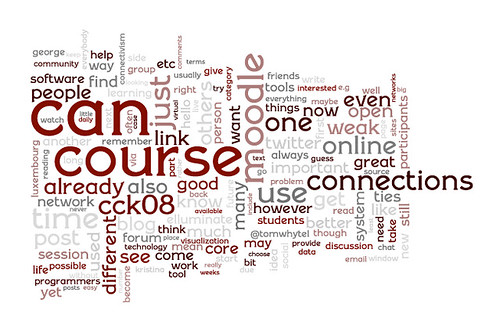The first week of the MOOC CCK08 (these abbreviations are already ingrained in my brain) is almost over. I still have a lot of work to do, but have to interrupt it after this post to prepare some stuff for work. Unfortunately, I cannot devote my entire waking hours to the course which I think would be extremely helpful at times to really follow up on interesting discussions and trying to contribute to them instead of just opening them in my tabs in Firefox. I don’t feel comfortable to jump into a very theoretical discourse if I still need to straighten out the basics in my head. Hopefully with time it will get better, my inner optimist encourages me. Of course, I don’t and can’t follow all discussions, but at least the ones that I am interested in should be possible. 🙂
The “Mookies” (Stephen Downes coined that name for people who participate in a MOOC) have been producing a lot of writing, video, concept maps and other visualizations in this past week. The visualizations certainly help me to get a better idea of the connections among us all and to sort out the many participants.
Tom Whyte and Trevor Meister try to come up with visual representations of our networks. Tom has started on the Twitter connections and Trevor put forward his ambitious and awesome ideas in his blog entry “Visual Network Interactions in CCK08“. As of now, Tom had already nine Twitter networks connected and there will hopefully be added many more. There are common connections already within these nine networks, and the network map starts to become complex. Pretty soon, we will need to invest in screens as big as walls and have them multi-touch enabled to navigate through this visualization. 🙂
I order to see where I have been active and to reflect on my sparse activity during the week, I collected all Moodle and blog posts as well as tweets connected to the the course and put them in the infamous Wordle. Of course, I already knew where my emphasis was in the discussions, but maybe I had missed something which could have come up in the visualization.

Common English words as well as numbers have been removed by the program which leaves the most often used words in the visualization. As you can see, “course”, “can” (isn’t that also a common English word?), “use”, and “moodle” dominate the word cloud. I never imagined being drawn into a discussion on Moodle as much as a I was, but that is what happened and where I posted mainly. In hindsight, this forum, albeit I am not an expert on Moodle and there are participants in the course who are much more familiar with the software, was a safe place for me because I knew the topic, had read about advantages and disadvantages of virtual learning environment, had tried a few myself, have worked with them for several years now and was confident that I could contribute something. Although it was a safe spot, that does not mean that it was not challenging, just not challenging in the same way as if I had tried to wrap my mind around a less familiar topic.
My resolution for the coming weeks is to spread out more thematically to the discussions closer to connectivism trying to geet a better understanding of the theory. I am not sure yet, if the coming epistomological week will actually be the perfect week to start with ;-), but I will try my best and stick with the discussions even though I may be a more silent observer.
For this week’s Wordle, I have tried several versions as the words are redrawn every time you select a different font. Finally, I chose the one above as it gives me hope for my New Year’s course resolution. “Connections” sticks out a bit from the rest of the words and I take that as a sign for the next weeks: Look out for new connections and foster the ones that have started growing and that I want to keep. Connect week 1 with the coming ones.
The gathering of the data I used to feed to Wordle showed me that I will need a different strategy if I want to continue doing that for the next weeks. It’s been only one week and I had to remember where I had posted. It was rather easy for Moodle because you can access all forum posts of one person in the profile. However, for the blog entries it would have been more difficult had I posted more. In the first instance I even forgot Twitter. So I went back there, got my tweets out with Tweetake, the service Tom uses for his experiment, and fed it to Wordle as well. Next time, I guess, I should also include Facebook. The only thing I can think of right now is to paste anything immediately after posting into a document to keep track of. That’s the disadvantage of the distributed discussions, but I would not change that for the sake of ease to gather data. That would be like adapting your teaching to the technology that is available and being unhappy about it.
To end this post on an optimistic note, I am looking forward to the continued discussions, (visual) experiments, live online sessions (I hope I can make the Elluminate session on Wednesday) besides starting the new semester and everything that comes with that.
![]() This work is licensed under a Creative Commons Attribution-ShareAlike 4.0 International License.
This work is licensed under a Creative Commons Attribution-ShareAlike 4.0 International License.